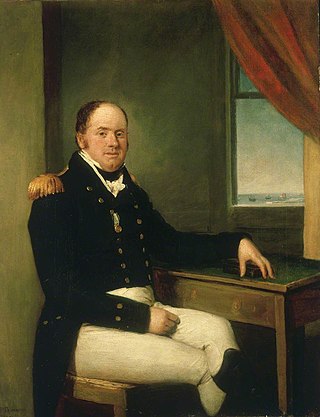
Vice-Admiral Sir Thomas Masterman Hardy, 1st Baronet, GCB was a British Royal Navy officer. He took part in the Battle of Cape St. Vincent in February 1797, the Battle of the Nile in August 1798 and the Battle of Copenhagen in April 1801 during the French Revolutionary Wars. He served as flag captain to Admiral Lord Nelson, and commanded HMS Victory at the Battle of Trafalgar in October 1805 during the Napoleonic Wars. Nelson was shot as he paced the decks with Hardy, and as he lay dying, Nelson's famous remark of "Kiss me, Hardy" was directed at him. Hardy went on to become First Naval Lord in November 1830 and in that capacity refused to become a Member of Parliament and encouraged the introduction of steam warships.
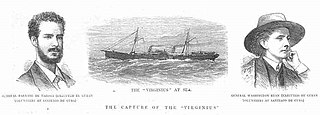
The Virginius Affair was a diplomatic dispute that occurred from October 1873 to February 1875 between the United States, Great Britain, and Spain during the Ten Years' War. Virginius was a fast American ship hired by Cuban insurrectionists to land men and munitions in Cuba to attack the Spanish regime there. It was captured by the Spanish, who wanted to try the men onboard as pirates and execute them. The Spanish executed 53 men but stopped when the British government intervened.

Rear Admiral Sir Thomas Troubridge, 1st Baronet was a Royal Navy officer. As a junior officer he saw action at the Battle of Sadras in February 1782 during the American Revolutionary War and the Battle of Trincomalee in September 1782 during the Anglo-French War. He commanded the third-rate Culloden at the Battle of Cape St Vincent in February 1797 during the French Revolutionary Wars. He went on to be First Naval Lord and then served as Commander-in-Chief, East Indies, during the Napoleonic Wars.
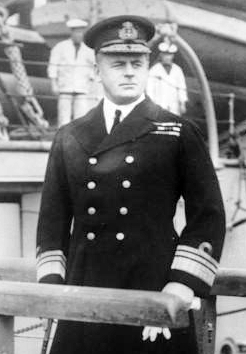
Admiral of the Fleet The Honourable Sir Hedworth Meux was a Royal Navy officer. As a junior officer he was present at the bombardment of Alexandria during the Anglo-Egyptian War.

Henry Roberts (1756–1796), a native to Shoreham, Sussex, was an officer in the Royal Navy who served with Captain Cook on his last two voyages.

Sir Richard John Strachan, 6th Baronet GCB was a British officer of the Royal Navy during the French Revolutionary and Napoleonic Wars, eventually rising to the rank of admiral. Sir Dicky, as his friends referred to him, was the last Chief of Clan Strachan. The Baronetcy became dormant in 1854 as he died without male heir.
Eustace Broke Loraine was a pioneer British aviator and the first Royal Flying Corps officer to be killed in an aircraft crash.

Sir Charles Knowles, 1st Baronet was a British naval officer who served in the Royal Navy, seeing service during the War of Jenkins' Ear, the wider War of the Austrian Succession, and the Seven Years' War. He also briefly served under the Imperial Russian Navy during the Russo-Turkish War. He rose to the rank of Admiral in a long and varied career, crowned with both success, and at times, controversy.

Vice-Admiral Sir George John Scott Warrender, 7th Baronet, was a Royal Navy officer during World War I.

Rear Admiral Charles John Austen CB was an officer in the Royal Navy and the youngest brother of novelist Jane Austen. He served during the French Revolutionary and Napoleonic Wars, and beyond, eventually rising to the rank of rear-admiral.

The third USS Despatch was a United States Navy steamer in commission from 1873 to 1891.

Sir Percy Lyham Loraine, 12th Baronet, was a British diplomat. He was British High Commissioner to Egypt from 1929 to 1933, British Ambassador to Turkey from 1933 to 1939 and British Ambassador to Italy from 1939 to 1940. In later life he was involved in breeding thoroughbreds for horse racing and won the 2000 Guineas Stakes in 1954 with Darius. He was the last of the Loraine baronets, having no sons to succeed him.

The 2nd battle of Santiago de Cuba, which took place on 9 April 1748, was a failed attempt by elements of the British Royal Navy under Rear-Admiral Charles Knowles to force the entrance of the port of Santiago de Cuba with the aim of striking a blow to the Spanish trade and privateering, since Santiago was a major base of the Spanish privateers in the Caribbean. Two British ships of line were put out of action by the batteries of Morro Castle and had to be towed to open sea. The remaining British warships retreated soon after.
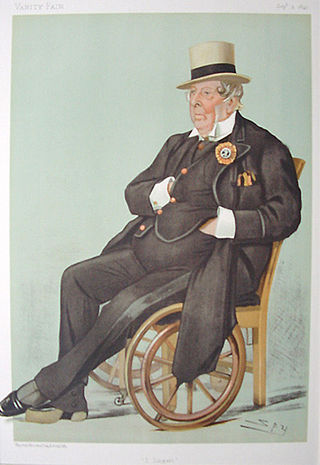
John Loraine Baldwin was a prominent English cricket enthusiast who was a co-founder of the I Zingari nomadic cricket club.
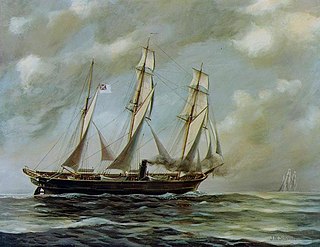
Tornado was a bark-rigged screw steam corvette of the Spanish Navy, first launched at Clydebank, Scotland in 1863, as the Confederate raider CSS Texas. She is most famous for having captured the North American filibustering ship Virginius, which led to the "Virginius Affair", which afterwards led to the Spanish-American Crisis of 1873.
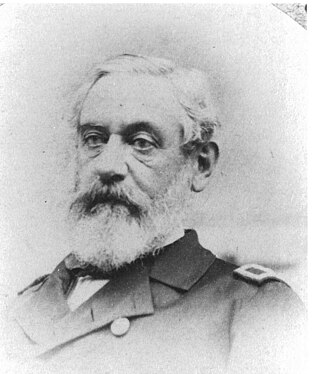
Gustavus Hall Scott was an officer in the United States Navy who served in the Second Seminole War and the American Civil War. He rose to the rank of rear admiral and late in his career was commander-in-chief of the North Atlantic Squadron.

Vice-Admiral Sir Charles George Frederick Knowles, 4th Baronet was an officer of the Royal Navy, who saw service during the Second Burmese War and in command on the Niger expedition and quelling uprising at Santa Cruz, eventually rising to the rank of vice-admiral.
Loraine is a feminine given name that is a modern form of the Germanic Chlothar. It is a name that originates from the French region of Lorraine. Notable people known by this name include the following:

Lady Jean Alice Elaine Cochrane was a Welsh and Scottish aristocrat. She was the daughter of Winifred, Countess of Dundonald and Douglas Cochrane, 12th Earl of Dundonald.
Rear-Admiral Polycarpus Taylor was a Royal Navy officer of the eighteenth century, most notable for his service commanding ships in the West Indies during the War of the Austrian Succession. Having joined the Royal Navy some time before 1733, Taylor served at the Battle of Cartagena de Indias and Invasion of Cuba before being promoted to commander in 1742. After commanding several vessels and being promoted to post-captain, in August 1744 Taylor took command of HMS Fowey; serving in the English Channel he ran ashore and destroyed the French privateer Griffon in 1745.



















